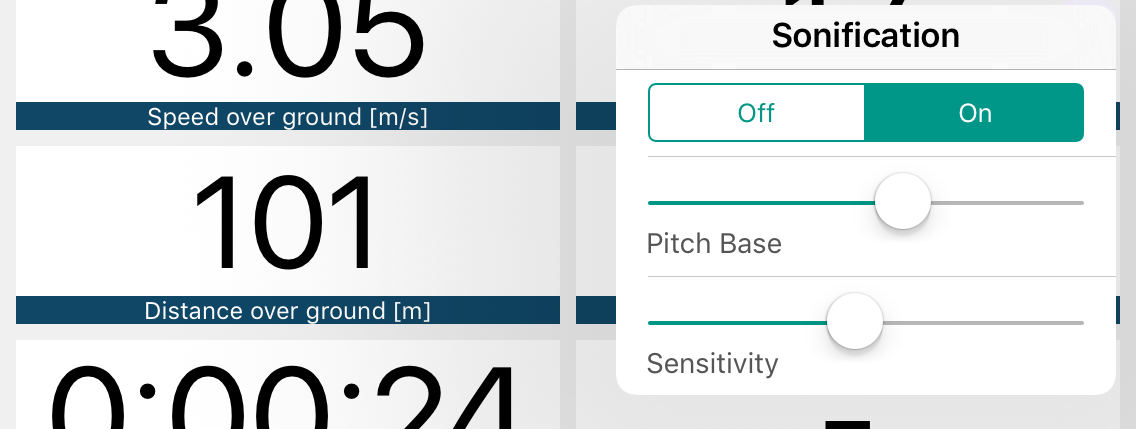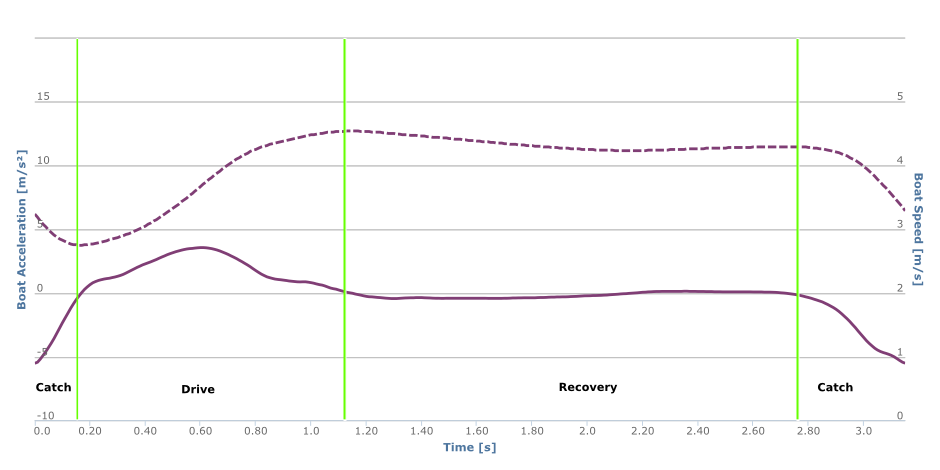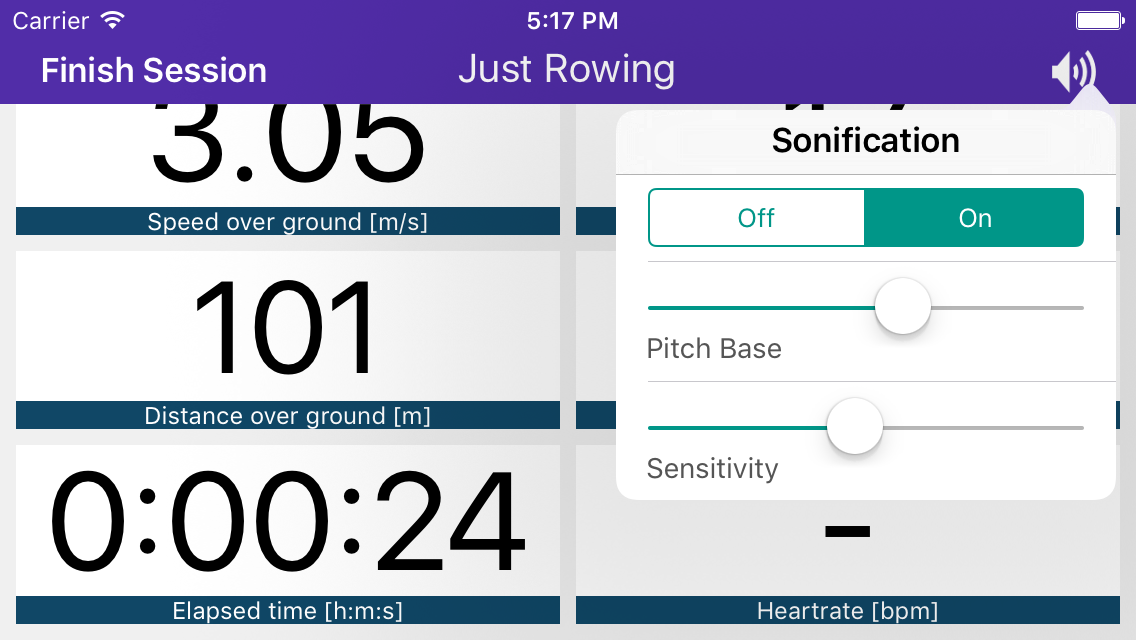
Listen to your Boat – Effectively Using Sonification in Rowing
Sonification refers to the process of representing time-series data acoustically, as sound, in contrast to the commonly used visual representations like graphs. While visual representation of performance parameters in rowing is important for its accuracy, visual representation has some challenges when we want to it for the purpose of live feedback on the water. Acoustic feedback on the other hand has certain desirable properties that make it an ideal complement to traditional visual feedback in rowing.
In this article I want to explore the usefulness of sonification in rowing and how you can apply it to your own coaching as well as give you pointers to some of the research conducted in this domain.
Visual and Acoustic Perception
In coaching rowers today we rely almost exclusively on feedback through visual perception. However there would be many advantages to using more acoustic feedback mechanisms instead of visual mechanisms.
For starters, athletes would no longer need to look at e.g. a display during the stroke, which means no unnecessary modification of their motion sequence. It is well asserted that the orientation of the head plays an important role in “steering” the pose and movement of the upper body. Removing the need to look at a display would certainly reduce this type of distraction. At the same time, any potential issues with displays (of any kind) in rowing like sunlight-readability, water-drops covering up the screen etc. are not relevant for acoustic feedback.
But one of the most overlooked advantages of acoustic feedback is that athletes can usually better correlate it to their own perception. Let’s explore why this is the case.
Acoustic perception has high temporal resolution, which means the athlete can very precisely determine when something happened and bring perceived events in order. I am sure you can relate this to your own experience, for example with music. When a single musician in a band is not perfectly aligned with the rhythm, our ears can easily recognize this.
Visual perception on the other hand has problems with recognising simultaneous events and bringing them in the correct order. If you watched that same band, would you be able to tell whether they’re all in sync? From experience we know that this task gets easier the slower the band plays. Even better if we are able to record the band on video and play it back frame by frame. The reason why it’s so much easier when the video is played back in slow-motion is that visual perception is slow: we need time to process the perceived information. Cinema movies for example need only 24 frames per second to create the illusion of continuous motion.
Visual perception has a big strength though: high spatial resolution. This means we can easily determine the relative size and location of objects, for examples the items in a visual representation. Contrast this with acoustic perception where this is much more difficult. Going back to the music analogy, you will most likely have difficulty in determining the number of semitones between two consecutively played notes by hearing unless you were a trained musician.
In summary, this means that visual and acoustic perception perfectly complement each other and this has implications on the type of feedback we should provide to athletes. Visual feedback should be used when high spatial resolution is required while acoustic feedback should be used when high temporal resolution is required.
Sonification of the Rowing Stroke
High temporal resolution is required whenever we want athletes to correlate their self-perception of a motion sequence to some form of measured data. The measured time-series data thus needs to be sonified, i.e. represented as a sound that the athlete can perceive.
There are many different ways to do this, but one way that provides high temporal resolution while preserving the largest amount information in the source signal is a continuous tone with varying pitch.
Let’s look at the sonification of boat acceleration. The following example is a replay of data recorded in a men’s pair (2-) in 2012. The crew has had serious problems coordinating well in the drive phase, which results in the big drive hump we can see in the acceleration graph. The drive hump refers to the phenomenon of a sudden loss in boat acceleration right after the initial acceleration following the catch. A more optimal stroke would maintain positive acceleration throughout the drive phase.
Listen to the sound in the video. I am sure you can clearly hear the “blip” when the crew goes through the drive-hump. Now imagine sitting in that boat and working on your technique and trying to improve the coordination with your partner. While you make adjustments to your timing of the motion sequence and force application you can immediately recognize the effect on the “blip” that you hear after the catch going through the drive hump. As you experiment with different things, you can quickly rule out what is effective in reducing the drive hump (and the “blip” you hear) and what isn’t.
Working with that particular crew and sonification, we were able to reduce the drive hump by focusing on a more consistent force-application through the leg drive between the partners. This led to the “valley” behind the drive hump to disappear almost entirely and maintaining positive acceleration throughout the drive.
The positive effects of using sonification in coaching athletes have received good scientific support for application in rowing and other sports (e.g. “german wheel” gymnastics).
Sonification in Coaching
Using sonfication is a very interesting way to give athletes a form of very direct feedback. However, closely listening to the acoustic signal and focusing on their own perception at the same time puts quite some strain on athletes. Use of sonfication should thus be limited to targeted exercises with a focus on improving a specific part of the rowing stroke. The goal should always be to improve an athlete’s “feel” for the boat. Sonification is thus a tool for the athlete to cross-check and improve their own perception, which is the only thing they can rely on during competition.
In my experiments with fellow coaches, I found sonification of boat acceleration especially useful for helping athletes improve their recovery and catch phase of the rowing stroke. Furthermore we found that adjusting the sound generated by the sonification system for each scenario individually improved how the athletes felt they were supported by the system.
Improving Recovery
Let’s look at the recovery. At steady-state stroke-rates (20spm) the recovery should result in a boat acceleration very close to zero. This maximizes fluid drag efficiency by minimizing variation in boat speed over the stroke cycle.

Variation of boat speed and boat acceleration for a stroke cycle at 20spm.
With a sonification system that maps boat acceleration to a change in pitch of a continuous tone, the athlete should aim to hear a tone of constant pitch during the recovery. Adjusting the sonification system for high sensitivity (large changes in pitch for small changes in acceleration) pronounces the effect an athletes movement in the boat has on the generated sound. A feedback we frequently got from athletes when using sonification was “I could hear how I was pulling my feet on the stretcher”.
An athlete should aim to maintain a constant the pitch of the tone for as long into the catch as possible, followed by a quick dip towards the catch.
Improving around the Catch
We found that two aspects of the stroke around the catch lend themselves particularly well to feedback with sonification.
The first aspect is how “smooth” the deceleration into the catch happens. Ideally, all members of the crew should “arrive” at the same time. A big part of that is that they should all apply force to the stretcher at the same time to stop and reverse their sliding seat. Nobody should arrive early and “sit and wait” at the catch.
In the acceleration graph from the example above we can see that there’s a “bump” in the deceleration phase at the catch around the three second mark. Using sonification, this bump is easily recognizable as an unsteady change in pitch. Because this typically happens at low acceleration values, we found it helpful to decrease the sensitivity of the sonification towards acceleration changes and raise the base-pitch (i.e. the pitch that corresponds to zero acceleration). This way, the deceleration phase is mapped into a frequency range above the bass range where it is easier to recognize.
The second aspect we found sonification very useful for is the reversal of negative to positive boat acceleration directly after the catch. This should be a smooth transition as well. Any mismatched timing here will also result in an unsteady tone. As we’ve seen in the video example about the drive-hump above, the critical transition into the drive can be represented very effectively using sonification as well.
Sonification with Rowing in Motion
In our experiments we used the sonification features in Rowing in Motion with an external Bluetooth Speaker that was loud enough so the whole crew could hear the sound. For singles we also used A2DP capable Bluetooth earplugs. The App can also live transmit the signal to the coach so that he can listen to the same sound. We found this very helpful for instructing the athletes on what to “look” out for in the sound.

Sonification Settings in the Rowing in Motion App
The App allows you to easily turn on and off sonification and quickly adjust the base pitch and sensitivity of the sonification.
I hope this article has inspired you to look into using this innovative feedback method with your athletes or use it yourself in the single. I’d be curious to hear about your results. If you like this article, you may also want to check out any of my other articles on this website about rowing biomechanics, rowing technique and everything related to rowing faster.
